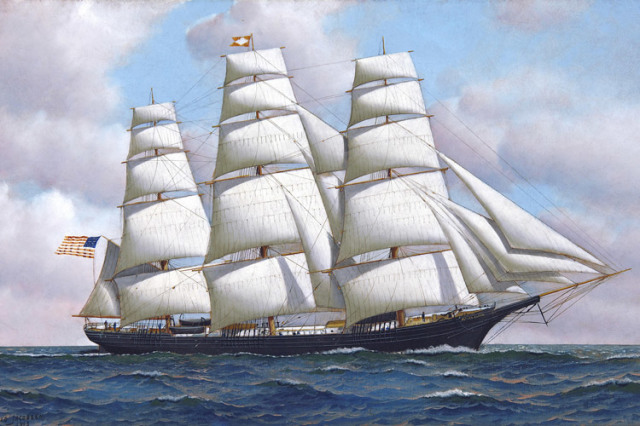A clipper was a type of mid-19th-century merchant sailing vessel, designed for speed. Clippers were generally narrow for their length, small by later 19th century standards, could carry limited bulk freight, and had a large total sail area. "Clipper" does not refer to a specific sailplan; clippers, by sailplan, may be schooners, brigs, brigantines, etc., or indeed "ships" as restrictively defined in the Age of Sail. Clipper ships were mostly constructed in British and American shipyards, though France, Brazil, the Netherlands and other nations also produced some. Clippers sailed all over the world, primarily on the trade routes between the United Kingdom and China, in transatlantic trade, and on the New York-to-San Francisco route around Cape Horn during the California Gold Rush. Dutch clippers were built beginning in the 1850s for the tea trade and passenger service to Java.
The boom years of the clipper ship era began in 1843 in response to a growing demand for faster delivery of tea from China. This continued under the stimulating influence of the discovery of gold in California and Australia in 1848 and 1851, and ended with the opening of the Suez Canal in 1869. While composite iron-framed wooden clippers continued to be built into the 1870s, sailing ships of the next generation had iron hulls. The last full-rigged composite passenger clipper, Torrens, was launched in 1875, while iron-hulled clippers continued to be built for the Australian wool trade into the 1890s.
The first ships to which the term "clipper" seems to have been applied were the Baltimore clippers, developed in Chesapeake Bay before the American Revolution, and reaching their zenith between 1795 and 1815. They were small, rarely exceeding 200 tons OM. Their hulls were sharp ended and displayed a lot of deadrise. They were rigged as schooners, brigs or brigantines. In the War of 1812 some were lightly armed, sailing under Letters of Marque and Reprisal, when the type—exemplified by Chasseur, launched at Fells Point, Baltimore in 1814—became known for her incredible speed; the deep draft enabled the Baltimore clipper to sail close to the wind. Clippers, running the British blockade of Baltimore, came to be recognized for speed rather than cargo space.

